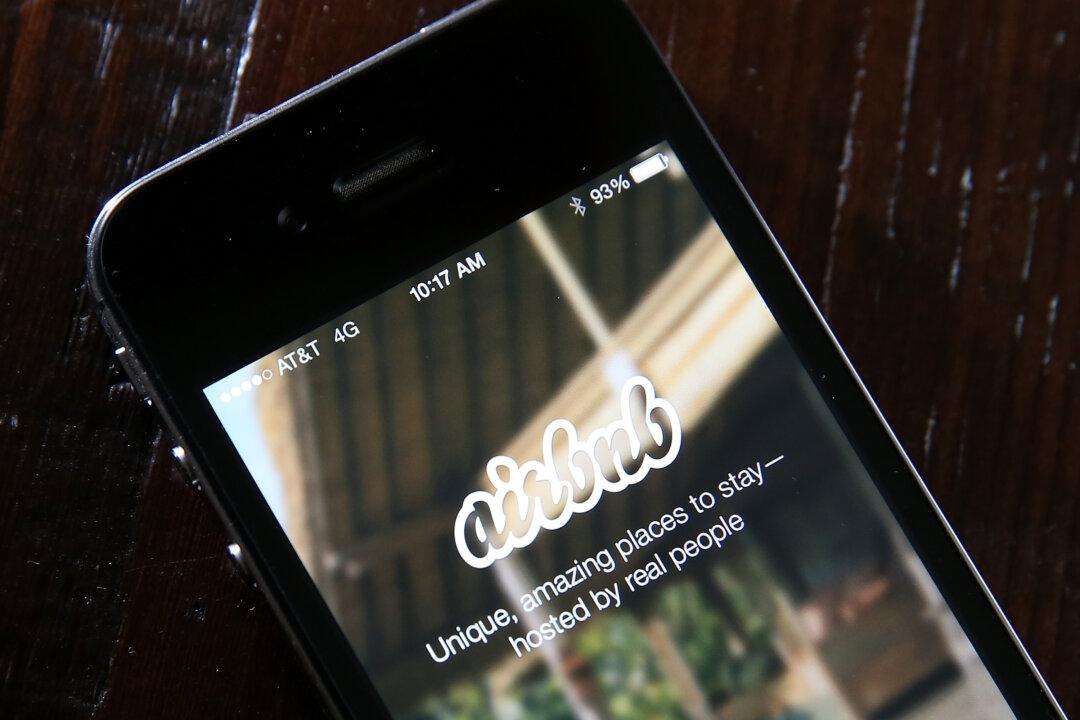NEW YORK—As the densest city in the country, New York City by nature is something of a shared economy. With food and building co-operatives, public parks operated by conservancies, and low car and home ownership rates, sharing is more like a way of life for the average New Yorker.
But it’s a type of pre-digital sharing, explains professor Arun Sundararajan, a unique hurdle for new companies like Airbnb, Uber, and Lyft—all digital sharing companies.
Sundararajan, whose area of study focuses on how digital technologies impact businesses and communities, and has been prolific on the topic of shared economies, said he would hope to see greater equity and greater life experiences for people who could not otherwise afford them.
However, he said “Areas like New York City face the biggest challenge in the transition to digital [sharing].”
In areas where consumers would typically get the most value out of sharing, New York City’s regulations run far deeper and are more complex than most other cities.
For example, New York City has a detailed set of codes governing the many aspects of the sectored multibillion-dollar car service industry. While the value of a yellow cab medallion rose to $1 million, other cities had even banned medallion sales.
Newer companies said they are apps and platforms providing a service, and the rules existing companies abide by do not apply to them. Existing companies unsurprisingly find it unfair that a tech company can come in to reap the same benefits while picking and choosing which laws it wants to comply with.
Why Deregulation Sounds Scary
Sometimes the well-intentioned services companies want to provide very obviously violate existing laws.
Lyft’s original model of ride-sharing, or “your friend with a car,” as the company puts it, does not even remotely fit into the Taxi and Limousine Commission’s (TLC) existing rules.
Airbnb is a platform that allows people to rent out their rooms and homes, yet a New York law prevents most apartments from being rented out for fewer than 30 days without the owner present. The 2010 law was put in place to prevent landlords from keeping residential units off the housing market for a more profitable use such as an illegal hotel, at the expense of pushing existing tenants out.
The critics are vocal. Housing advocates say Airbnb exacerbates the loss of affordable housing, a priority of the administration. Taxi stakeholders also bring up safety and business issues with the introduction of companies that started out focused on ridesharing.
When Uber started aggressively recruiting for-hire-vehicle drivers, livery-base owners saw a dangerous shift in attitude.
“It’s piracy,” said Avik Kabessa, CEO of the global Carmel Car & Limousine and co-founder of the Livery Round Table, who is less concerned with losing drivers than having careless drivers on the road.
Usually if he hears one of his drivers violated a rule or did something unsafe, he would suspend the driver. Now when he does that, he is also at risk of losing the driver to an Uber or Lyft base of cars. “Drivers are saying, ”‘No, I have alternatives,’” Kabessa said.
Kabessa adds that he doesn’t think Uber has the same skin in the game other base owners do. Uber Corporation is affiliated with six bases in Long Island City, but a summons addressed to one of those bases doesn’t touch Uber itself in terms of culpability.
“So what muscle does the TLC have to enforce the rules?” Kabessa said.
The tech companies are equally armed with rhetoric. Uber’s new campaign manager David Plouffe—formerly President Barack Obama’s senior vice president of policy and strategy—likened Uber to a candidate in a political race, pitted against the incumbent: the taxi industry.
“Uber has the chance to be a once-in-a-decade, if not a once-in-a-generation company. Of course, that poses a threat to some, and I’ve watched as the taxi industry cartel has tried to stand in the way of technology and big change. Ultimately, that approach is unwinnable,” Plouffe stated in a blog post.
Other sharing companies have made similar remarks about disrupting the archaic practices of established industries while creating more public benefit.
Regulatory Push-Back
Often what the companies are doing is identifying a long-standing problem and solving it aggressively, sometimes to the point of creating new problems, and people in government recognize that.
Regulators are reluctant to engage in an unproductive us-versus-them dialogue.
After a judge overturned Airbnb’s motion to block the attorney general’s request for user tax information in April, Eric Schneiderman wrote an editorial on the clash between the tech companies and the regulators.
“Regulators are left struggling to keep up—and the companies involved want to keep it that way,” Schneiderman wrote.
“Cyberlibertarians argue that regulators often lack the tools or the know-how to provide smart enforcement. They are not entirely wrong. But that doesn’t mean regulation is unnecessary. Nor does it excuse those same critics for refusing to work with the government agencies that must develop those tools,” he continued.
In late July, Lyft, too, hit a wall with the attorney general office after city and state agencies tried to prevent a launch in New York City. The result was that Lyft launched, but not in a way that resembles its service in other cities.
“I hope that this doesn’t set the tone,” said Sundararajan, who thinks the message New York regulators have sent sharing companies is unfortunate.
This brings NYC to a unique crossroads, where on the one hand the mayoral administration has stressed several times its wish to foster tech companies and the sharing economy in the city, while notable sharing companies like Uber and Lyft have had to change their business models in order to operate in the city.
The attorney general’s office maintains the position that innovation can happen within existing regulatory boundaries, but many observers—the supporters and critics of sharing companies—said deregulation is just a matter of time.
“All the stakeholders are playing the roles you'd expect them to play,” Sundararajan said. “This is how regulatory change happens.”
“The value that could be possible is higher for New York than any other American city,” Sundararajan said.
Creating Change
In New York City, vehicles taking street hails and vehicles taking prearranged rides were originally separated to prevent abuses by way of customer discrimination. E-hails for yellow cabs and the new green cabs were seen as blurring those lines and unsurprisingly met with heavy opposition, dragging out the timeline for implementing both of these projects.
The airing of fears that industries will deregulate and chaos will ensue are some of the first signs of the move to digital. Like other industries’ digital transitions have shown (music, publishing, etc.), the step is not taken without casualties.
However, New York City is more or less past that stage in many regards. People can already see that, when you cut through the rhetoric, regulations are changing and companies are adapting to the rules in cities that work to make rules sensible and in the public interest.
With the taxi industry, the result has not been the sort of friendly carpool type of ridesharing Lyft envisions, however New York City’s existing and extensive transportation network is making more and more of an effort to integrate tech, lest there be a revolt.
The incumbents who spend years lobbying and cooperating with agencies to make even minor changes to regulations balk at the approach of fast-moving tech companies. Some see giving credit to these companies for pushing innovation by breaking laws as a sort of preferential treatment.
Uber, which has been credited with pushing the industry forward, has been operating in New York City since 2011, basically as a black car base. Black cars are typically scheduled in advance and kept for several hours, but Uber’s app allows the service to work on an on-demand basis, popularizing the service. In the black car sector alone, Uber-owned bases now have over 7,600 cars, about 46 percent of the total count of black cars.
Yellow cabs can only take street hails; green street hail liveries can take street hails only in certain zones, as well as prearranged rides; livery cabs, or community car service vehicles, can only take prearranged rides and must give the customer a quote at the beginning of the ride; black cars and limousines similarly cannot take street hails, but do not need to agree on a quote and can use a rate instead. Black cars and limos cannot take cash for more than 10 percent of their business, and typically serve corporate customers.
Tech had lobbied TLC to allow e-hails for all yellow cabs, but the TLC had pre-existing payment processor contracts, which meant they couldn’t allow payment by smartphone apps. In 2012 Uber tried to circumvent this by offering free rides, but the TLC shut the operation down.
Eventually a pilot for e-hail apps was launched with a period where the apps did not accept payment until the contracts expired, which was seen as a move spurred by the aggressive upstarts.
“The fact that it’s 2013 and you can finally e-hail a taxi is not something to be proud of,” said Ashwini Chhabra, then-deputy commissioner at TLC, at a Disrupt NYC conference. This May, the pilot was extended for another year.
Incumbent Advantage
The yellow cabs are iconic, and stakeholders don’t actually see the new players as significant competition.
Gene Friedman, owner of over 800 yellow cabs, said at a Crain’s New York event, e-hail apps should be competing for his business.
E-hails left livery cabs in a comparatively disadvantageous position. Carmel’s Kabessa created the first industry TLC-compliant car service app, but companies like Uber are vying for a sort of monopoly. If there is enough supply on one app, the customer has no need to open two others. Liveries also need to give customers a quote before the ride, and can’t as easily partner with existing services.
But Curb CEO Pat Lashinsky sees livery cabs as being uniquely positioned to compete with services like Uber and Lyft because of surge pricing.
Uber’s black car trips are more expensive when demand is high, and cheaper when demand is low. With yellow taxis, which operate using meters, and livery cabs, which set flat rates by destination based on zones, prices are more predictable.
“People don’t have an idea of what that really means,” Lashinsky said. “The difference between waiting two minutes and waiting three minutes might be a $10–$15 difference on a trip.”
Lashinsky recently rebranded the TLC-approved Taxi Magic e-hail app to Curb in order to reach out to the black car and livery sectors. Customers would need to enter their destination to see livery quotes, but drivers would not see the destinations until a ride is accepted. By having every type of car service on the same app, Lashinsky explained, customers will be able to better understand how pricing really works and shop around for the best price.
Reports of short Uber trips costing hundreds of dollars have been common, and the pattern of prices going way up in times of heavy rain or snow is only going to continue, Lashinsky said.
Curb, which operates in 60 cities, makes a point of partnering only with established businesses. “They’ve already passed all the regulatory hurdles, there’s a sense of safety and community in place … and there is a lot of availability all at once,” Lashinsky said.
Bureaucracy is expensive and slows things down, but in New York City the rules are largely in place because they make sense, according to Lashinsky. The level of compliance Lashinsky has seen from sharing companies is higher in New York City than other cities. It results in companies like Uber and Lyft changing the way they work to fit into existing regulations, but tech companies pride themselves on adaptability.
“In New York, they’re strict, and they’re good. There is a lot more follow up, and the regulations have more teeth than other cities,” Lashinsky said. “What we’ve seen is the regulations shift to allow for innovation.”
New Regulation
To a consumer who couldn’t hail a cab from his phone before 2013, regulatory change is moving at a glacial pace. But it’s to the credit of sharing companies that sometimes inherently provide services that go against existing laws that better business environments are being created, according to Sundararajan.
“The specification of different areas … complicates this for the startups that have to fight city by city, state by state, country by country, widely varying levels,” Sundararajan said. “It’s very interesting to me how much of the venture capital is being spent on regulatory reform.”
“It slows down early movers but … it lays a better foundation for future sharing models,” Sundararajan said. “It leads to a better business environment.”
Some cities have outright banned various sharing companies, which often launch even if they don’t receive approval from the local authorities. And every city has a different set of concerns.
Recently the Seoul City Council banned Uber, stating it and similar companies were illegal, and soon after announced it was launching it’s own app to provide a similar service. San Francisco’s local government is also funding and encouraging use of an e-hail app while combating services like Uber and Lyft.
The pattern has been that as the companies gain footholds in various cities, they force regulators to address new issues. Airbnb hosts sometimes attract squatters, licensed rideshare drivers sometimes pass their phones to unlicensed friends who can then act as drivers, companies order and cancel hundreds of rides from competitors, and sometimes passengers are getting into strangers’ cars thinking they are Uber or Lyft cars.
“I think there are some things that city governments will do to keep people safe,” Sundararajan said. “A lot of deregulation will also occur.”





